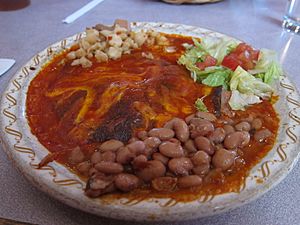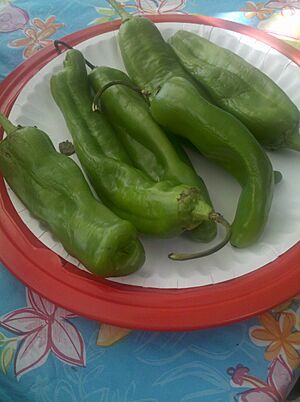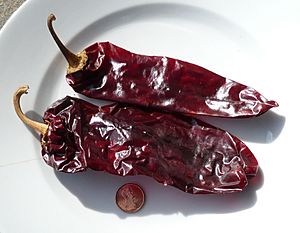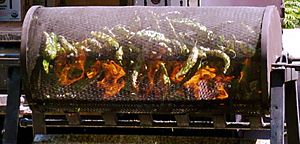New Mexico chile facts for kids
Quick facts for kids New Mexico chile |
|
|---|---|
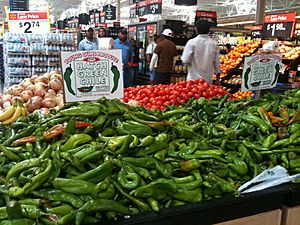 |
|
| Species | Capsicum annuum |
| Cultivar group | New Mexico |
| Marketing names | Hatch chile, green chile, red chile, Anaheim pepper |
| Breeder | Dr. Fabián García |
| Origin | New Mexico |
| Heat | |
| Scoville scale | 0–100,000 SHU |
New Mexico chile is a special type of chile pepper that comes from the US state of New Mexico. It was first grown by the Pueblo and Hispano communities.
Later, a scientist named Dr. Fabián García and his students at New Mexico State University helped create the modern New Mexico chile peppers we know today. This happened way back in 1894!
New Mexico chile usually starts green and then turns red as it ripens. It's super popular in the food of the Southwestern United States, especially in New Mexican cuisine. In fact, chile is one of New Mexico's official state vegetables! People in New Mexico even have a state question: "Red or Green?" This asks which color of chile sauce you want with your food.
Hatch chile is a special name for New Mexico chile grown in the Hatch Valley. This area is famous for its unique chile, which is sold all over the world!
New Mexico green chile tastes a bit like onion or garlic, but it's also subtly sweet, spicy, crisp, and smoky. When it ripens to red, it keeps that flavor but adds an earthy taste. The spiciness of New Mexico chile depends on the specific type.
Contents
History of New Mexico Chile
Many kinds of chile plants were first grown by the Pueblo long ago. They still grow their own special types today, each with its own unique taste and heat. For example, Zia Pueblo chile has a bitter-sweet flavor when it turns red.
When the Spanish arrived, they shared new ways to grow plants. This helped create new types of chile in their towns.
A pioneer scientist named Dr. Fabián García developed many New Mexican chile types. His most famous one was 'New Mexico No. 9', released in 1913. These chiles were bred to be hotter, just how New Mexicans liked them for their traditional dishes.
Dr. García started by choosing 14 different chile types from New Mexico and Southern Colorado. He wanted to create peppers that were "larger, smoother, fleshier," and good for canning.
Later, an expert named Paul Bosland started the Chile Pepper Institute at New Mexico State University. This institute studies New Mexico's famous state vegetable and other peppers from around the world.
How New Mexico Chile Plants Grow
New Mexico chile plants grow from seeds. Each type is specially bred to resist diseases and grow well in its own region. Things like how high up the land is, the weather, and the soil all affect how the chile tastes and how strong the plant is. This makes the New Mexican region perfect for growing chile.
The Rio Grande river area, mountains, and high deserts all provide the right environment. To keep each chile type healthy and flavorful, farmers carefully choose seeds from specific plants.
Sometimes, farmers need to get new seeds from their original growing areas every few generations. This helps keep the plants strong and flavorful, as older seeds can become weaker over time.
Growing Chile in New Mexico
New Mexico chile plants grown in New Mexico are the most popular. Their flavor, texture, and strength really depend on where they grow. The Pueblo people first grew their chiles in their own special soils, and this tradition continues today.
Many of the best chiles are grown along the Rio Grande river, especially in the Hatch Valley.
Hatch Chile
Hatch chile refers to types of Capsicum peppers grown in the Hatch Valley. This area stretches along the Rio Grande from Arrey, New Mexico to Hatch, New Mexico. The soil and growing conditions in the Hatch Valley give the chile a unique flavor. Most Hatch chile types were developed at New Mexico State University.
You can buy Hatch chile in many parts of the Southwest. Some sellers might use the "Hatch" name even if their chile wasn't grown there. To protect local farmers, New Mexico passed a law in 2012. It says that chile sold as "New Mexican" must actually be grown in New Mexico, or it needs a clear sign saying "Not grown in New Mexico."
Chile grown around Hatch is often sold fresh-roasted in late summer and early autumn.
Pueblo Chile
Pueblo chile plants have been grown by the Puebloan peoples of New Mexico for hundreds of years. Acoma Pueblo chile is mild and flavorful. The Isleta Pueblo chile becomes fruity and sweet when it turns red. The Zia Pueblo chile has a bitter-sweet taste when it ripens to red.
It's important not to confuse these ancient Pueblo varieties with a chile grown in Pueblo, Colorado, which is also called "Pueblo chile." That one is a different type.
Rio Grande Chile
Many other places along the Rio Grande, outside of the Hatch Valley, also grow excellent chile.
Towns and cities across New Mexico have strong chile traditions. These include Chimayo, Española, Lemitar, and San Antonio. Also, in the Albuquerque metropolitan area, towns like Albuquerque, Bosque, Corrales, Los Ranchos de Albuquerque, and Bosque Farms are known for their chile.
Growing Chile Outside of New Mexico
Anaheim Pepper
| Anaheim pepper | |
|---|---|
| Heat | |
| Scoville scale | 500–2,500 SHU |
An Anaheim pepper is a mild type of New Mexico chile. It's often grown outside of New Mexico. It's related to the 'New Mexico No. 9' chile. The name 'Anaheim' comes from Emilio Ortega, a farmer who brought the seeds from New Mexico to Anaheim, California, in 1894.
The spiciness of 'Anaheim' peppers can vary. On the Scoville scale, which measures heat, they range from 500 to 2,500 units.
Uses of New Mexico Chile
Food
Green chile is often roasted and peeled. It can be served whole, diced, or in sauces. It's a key ingredient in dishes like enchiladas, burritos, burgers, french fries, and rice. You can also find whole green chiles that are raw, fried, or baked as chiles rellenos. New Mexican chile rellenos are usually covered in egg batter and fried.
Many restaurants, even big national chains in New Mexico, offer green chile on their menus. They often show a "New Mexico Certified Chile" sign.
Red chile is simply green chile that has ripened. It's often dried and ground into a powder. This powder is then used to make a red chile sauce. To make the sauce, dried peppers are boiled and then blended with spices like onion and garlic. Red chile powder is usually mixed with water and spices.
If you order a dish with both red and green chile, it's called "Christmas" style!
Art and Decoration
Chiles are used to make decorative items like ristras and chile wreaths. A ristra is a string of drying chile pods. They are very popular decorations in New Mexico and are a symbol of the state's culture. Some families still use ristras to dry their red chile.
Some types of chile plants have colorful fruits and are grown just for their beauty.
Other Industries
Some chile types, like 'NuMex Garnet', are used to make red dye.
Chile and New Mexico's Economy
Chile is a very important crop for New Mexico's economy and culture. In 2019, New Mexico grew about 77% of all the chile peppers in the United States!
Harvesting Chile
Chile is planted in New Mexico in March and April. Green chile is harvested between July and October, and red chile is harvested from October to December.
Harvesting chile is difficult because the plants are delicate, and the peppers can be easily damaged. Farmers often use both local workers and seasonal workers from Mexico. Scientists are working on machines to harvest chile, but it's a challenge because the peppers are so fragile.
New Mexico Certified Chile Program
In 2014, a program called "New Mexico Certified Chile" was started. This program makes sure that chile sold as "New Mexican" was actually grown in New Mexico. It helps protect customers from fake products and supports local farmers.
Cultural Impact of New Mexico Chile
New Mexico chile has a huge impact on the state's food, art, and culture. The chile pepper's shape, its red and green colors, and even its outline have become symbols of New Mexican cultural identity. You can see chile designs on company logos, public art, and even bridges!
New Mexico is the only state with an official State Question: "Red or green?" The State Answer is "Red and green or Christmas." This question refers to the choice of chile sauce at restaurants. Answering "Christmas" means you want both red and green chile on your dish.
Chile is also one of New Mexico's official state vegetables. One of the state's license plate designs, the Chile Plate, even features red and green chile!
The village of Hatch, New Mexico is known as the "Chile Capital of the World." It has hosted an annual "Chile Festival" every summer since 1971.
"Chile" vs. "Chili"
In most of the world, "chile" and "chili" both mean the pepper. But in New Mexico, "chile" (pronounced chill-ee) means the pepper itself. "Chili" refers only to chili con carne, which is a meat dish popular in Texas. So, if you say "green chile chili," it means chili con carne made with green chile!
Many people in New Mexico, including farmers and tourism groups, try to teach others about this difference in spelling. Using "chili" when you mean the New Mexico pepper can sometimes be seen as disrespectful by locals.
None of these spellings should be confused with the country of Chile (pronounced: chill-lay), which is a completely different word.
Chile Roasting Season
The first fresh chile of the year usually arrives in New Mexico around August. This marks the start of "roasting season"! Stores, even big ones like Albertsons and Walmart, set up special machines called 'chile roasters' outside.
A chile roaster is a big drum that spins over powerful flames. Customers buy a box of chile, and the roaster loads it into the drum. As the drum turns, the chiles tumble over the fire. This makes their skins blister and peel off easily. This process is very popular because you can see, hear, and smell the chiles roasting. The smell of roasting chile is a classic part of early autumn in New Mexico!
The skins of roasted chiles are not eaten. Peeling the chiles to freeze them is a traditional family activity. Some people eat fresh roasted chiles as a snack, but it's best to cook them to 165°F (74°C) before eating.
While less common now, roasting chile in a traditional horno (outdoor oven) is an older method. Many people also roast chiles over an open flame on their gas stoves or grills.
Types of New Mexico Chile
New Mexico chiles come in many types. Most are long, pod-shaped peppers that turn from green to red. However, they can have slightly different tastes, appearances, and heat levels. Some varieties might even turn yellow, orange, or brown.
Some common New Mexico chile plants are 'New Mexico 6-4', 'Big Jim', 'Sandia', 'No. 6', and 'No. 9'. Newer types like 'Heritage 6-4' and 'Sandia Select' grow even better and are more consistent.
There are also unique "landrace" chiles, which are older types grown in specific areas. These include 'Chimayó', 'Velarde', 'Jemez', and 'Española'. They have their own special tastes and often cost more.
| Cultivar | Description | Length | Width | Pod type | Scoville heat units | ||||||||||||||||||
|---|---|---|---|---|---|---|---|---|---|---|---|---|---|---|---|---|---|---|---|---|---|---|---|
| 6-4 | An old type developed by Fabián Garcia. | 6.6 inches (17 cm) | 3.8 inches (9.7 cm) | New Mexican | 300 ~ 500 | ||||||||||||||||||
| 6-9 | An old type developed by Fabián Garcia. | New Mexican | |||||||||||||||||||||
| Acoma | Pueblo chile grown in Acoma Pueblo. | New Mexican | |||||||||||||||||||||
| Alcalde | A traditional New Mexico chile. | New Mexican | |||||||||||||||||||||
| Anaheim | A mild relative of 'NuMex no. 9', grown outside New Mexico. Its flavor and heat can vary a lot. | New Mexican | 500 ~ 2,500 | ||||||||||||||||||||
| Barker's Hot | A very hot New Mexico type. Red fruits are hotter than green ones. | 5–7 inches (13–18 cm) | New Mexican | 15,000 ~ 30,000 | |||||||||||||||||||
| Bailey Piquin | As hot as habanero peppers. This type can be harvested by machine and is mainly used for chile powder. | Piqiun | 90,000 ~ 100,000 | ||||||||||||||||||||
| Big Jim | Developed by Jim Lytle and NMSU. Holds the record for the longest chile (17 inches in 2012!). | 7–17 inches (18–43 cm) | 7–17 inches (18–43 cm) | New Mexican | 500 ~ 3,000 | ||||||||||||||||||
| Centennial | Mostly for decoration; turns purple, then yellow, orange, and red. Used in potted plants. | Piquin | - | Chimayó | A medium-spicy pepper, green before turning dark red. Grown in Chimayó, New Mexico. It's small, curled, and has a sweet, smoky flavor. | 4.5 inches (11 cm) | New Mexican | 4,000 ~ 6,000 | |||||||||||||||
| Conquistador | A very mild pepper with no heat. Used for mass-produced chile rellenos. | 6.18 inches (15.7 cm) | 2.76 inches (7.0 cm) | New Mexican | 0 | ||||||||||||||||||
| Eclipse | Turns brown when ripe. Part of a line of peppers that ripen to colors other than red. | 5.1 inches (13 cm) | 1.9 inches (4.8 cm) | New Mexican | 300 ~ 500 | ||||||||||||||||||
| Escondida | A traditional New Mexico chile. | New Mexican | |||||||||||||||||||||
| Española | An old chile type with a slightly stronger, bitter flavor. Ripens early to red. First grown by Spanish settlers near modern-day Española. | 4.9 inches (12 cm) | 1.5 inches (3.8 cm) | New Mexican | 1,500 ~ 2,000 | ||||||||||||||||||
| Española Improved | A mix of Sandia and Española. Tastes like Española but grows better and has larger peppers. | 6.0 inches (15 cm) | 1.75 inches (4.4 cm) | New Mexican | 1,500 ~ 2,000 | ||||||||||||||||||
| Fresno | Related to Santa Fe Grande. Grows upright and turns orange and red. Moderately spicy. | 2.0 inches (5.1 cm) | 1.0 inch (2.5 cm) | Santa Fe Grande | 2,500 ~ 10,000 | ||||||||||||||||||
| Garnet | A machine-harvestable type with low heat, used for dye. | 6.2 inches (16 cm) | 1.5 inches (3.8 cm) | New Mexican | 150 ~ 160 | ||||||||||||||||||
| Heritage 6-4 | The original 'New Mexico 6-4' flavor was brought back from old seeds. | 6.7 inches (17 cm) | 3.7 inches (9.4 cm) | New Mexican | 1,559 | ||||||||||||||||||
| Heritage Big Jim | More uniform in shape and heat than regular 'Big Jim' peppers. | 7–12 inches (18–30 cm) | New Mexican | 500 ~ 1,000 | |||||||||||||||||||
| Holiday Ornamentals | Upright peppers grown for decoration. Includes types like 'NuMex Valentine's Day' and 'NuMex Christmas'. | Piquin | - | Isleta | Pueblo chile grown near the Rio Grande Bosque around the Pueblo of Isleta. | New Mexican | |||||||||||||||||
| Jemez | A traditional New Mexico and Pueblo chile grown near Jemez Pueblo. | New Mexican | |||||||||||||||||||||
| Joe E. Parker | A thicker '6-4' type. Its heat changes based on where it grows. | 6.5 inches (17 cm) | 2.0 inches (5.1 cm) | New Mexican | 800 ~ 900 | ||||||||||||||||||
| Luci Fairy | 30,000 ~ 50,000 | ||||||||||||||||||||||
| Marisol | Named because its fruit "points" to the sun (mirasol means "looking at the sun" in Spanish). | 2.17 inches (5.5 cm) | 0.75 inches (1.9 cm) | Marisol | - | Nematador | A cayenne-type chile that resists tiny worms called nematodes. | 5.8 inches (15 cm) | 0.6 inches (1.5 cm) | Cayenne | 15,500 ~ 16,000 | ||||||||||||
| No. 6 | An old type developed in 1950 by Dr. Roy Harper. | New Mexican | 700 ~ 900 | ||||||||||||||||||||
| No. 9 | The very first New Mexican pod type chile, developed by Dr. Fabián García. It was made milder for more people to enjoy. | New Mexican | 1,000 ~ 1,500 | ||||||||||||||||||||
| Piñata | A type of 'early jalapeño' that changes colors to yellow, orange, and red. | Jalapeño | 35,000 ~ 50,000 | ||||||||||||||||||||
| Primavera | A consistently mild jalapeño type. | 2 inches (5.1 cm) | 1 inch (2.5 cm) | Jalapeño | 8,500 ~ 9,000 | ||||||||||||||||||
| R Naky | Developed in 1985 from a mix of other chiles. | 5.5 inches (14 cm) | New Mexican | 260 ~ 760 | |||||||||||||||||||
| Rio Grande | New Mexican | 2,500 ~ 5,000 | |||||||||||||||||||||
| Rio Grande 21 | A large, mild pepper. | 6.7 inches (17 cm) | 1.73 inches (4.4 cm) | New Mexican | 500 ~ 700 | ||||||||||||||||||
| San Filipe | A traditional New Mexico chile. | New Mexican | |||||||||||||||||||||
| Sandia | Developed in 1956 by Dr. Roy Harper. | 6.6 inches (17 cm) | 1.7 inches (4.3 cm) | New Mexican | 1,500 ~ 2,000 | ||||||||||||||||||
| Sandia Select | An improved 'Sandia' pepper that is spicier and grows better. | 6–7 inches (15–18 cm) | 1–2 inches (2.5–5.1 cm) | New Mexican | 20,000 ~30,000 | ||||||||||||||||||
| Suave Orange | A mild type of C. chinense pepper. | 1–2.5 inches (2.5–6.4 cm) | 1–2 inches (2.5–5.1 cm) | Habanero | 774 | ||||||||||||||||||
| Suave Red | A mild type of C. chinense pepper. | 1–2.5 inches (2.5–6.4 cm) | 1–2 inches (2.5–5.1 cm) | Habanero | 335 | ||||||||||||||||||
| Sunburst | Grown for decoration, used for miniature wreaths. Turns orange. | 2.78 inches (7.1 cm) | 0.5 inches (1.3 cm) | de Arbol | - | Sunflare | Grown for decoration. Turns red. | 2.87 inches (7.3 cm) | 0.4 inches (1.0 cm) | de Arbol | - | Sunglo | Grown for decoration. Turns yellow. | 3.26 inches (8.3 cm) | 0.54 inches (1.4 cm) | de Arbol | - | Sunrise | Turns yellow. Part of a line of peppers that ripen to colors other than red. | 7.1 inches (18 cm) | 1.5 inches (3.8 cm) | New Mexican | 300 ~ 500 |
| Sunset | Turns orange. Part of a line of peppers that ripen to colors other than red. | 6 inches (15 cm) | 1 inch (2.5 cm) | New Mexican | 300 ~ 500 | ||||||||||||||||||
| Sweet | A high-yield, low-heat type. | New Mexican | 200 ~ 300 | ||||||||||||||||||||
| Taos | Pueblo chile grown near Taos Pueblo in the Taos Mountains. | New Mexican | |||||||||||||||||||||
| Twilight | A decorative type that turns purple, yellow, orange, then red. It's also resistant to a plant virus. | Piquin | - | Valverde | A traditional New Mexico chile. | New Mexican | |||||||||||||||||
| Vaquero | A jalapeño type with good flavor. | 2.5 inches (6.4 cm) | 0.9 inches (2.3 cm) | Jalapeño | 25,000 ~ 30,000 | ||||||||||||||||||
| XX Hot | A very hot New Mexico type, developed at New Mexico State University. | 3–5 inches (7.6–12.7 cm) | New Mexican | 60,000 ~ 70,000 | |||||||||||||||||||
| Zia | Pueblo chile grown near Zia Pueblo. | New Mexican |
-
- Mainly used as ornamental.
Images for kids


